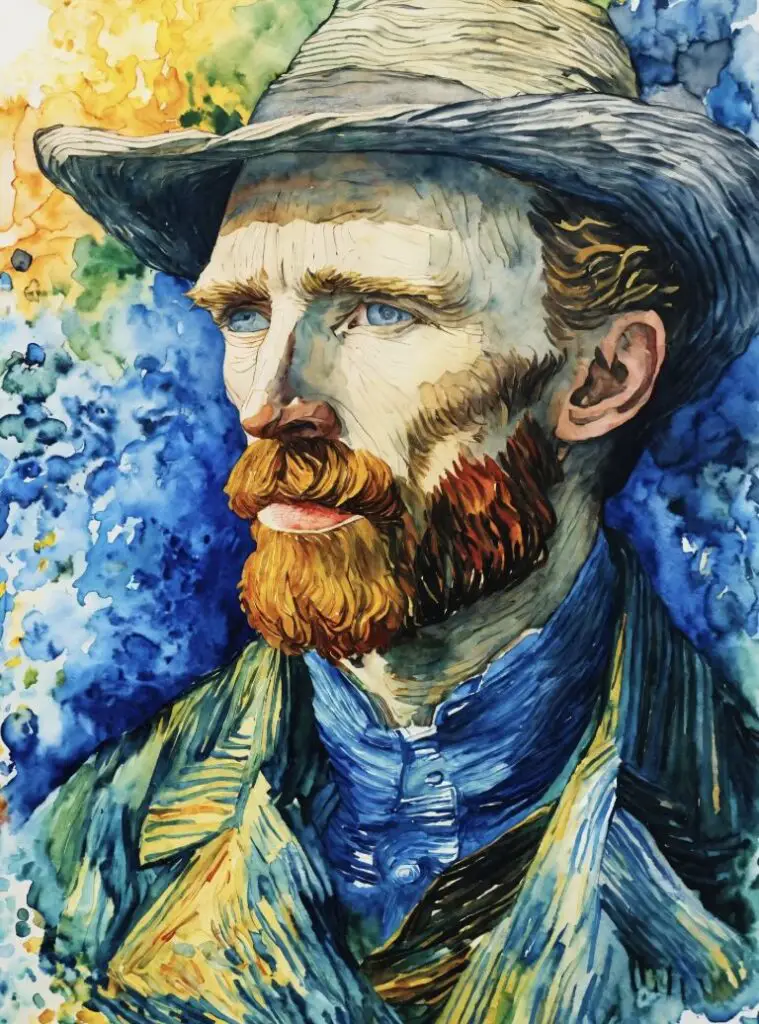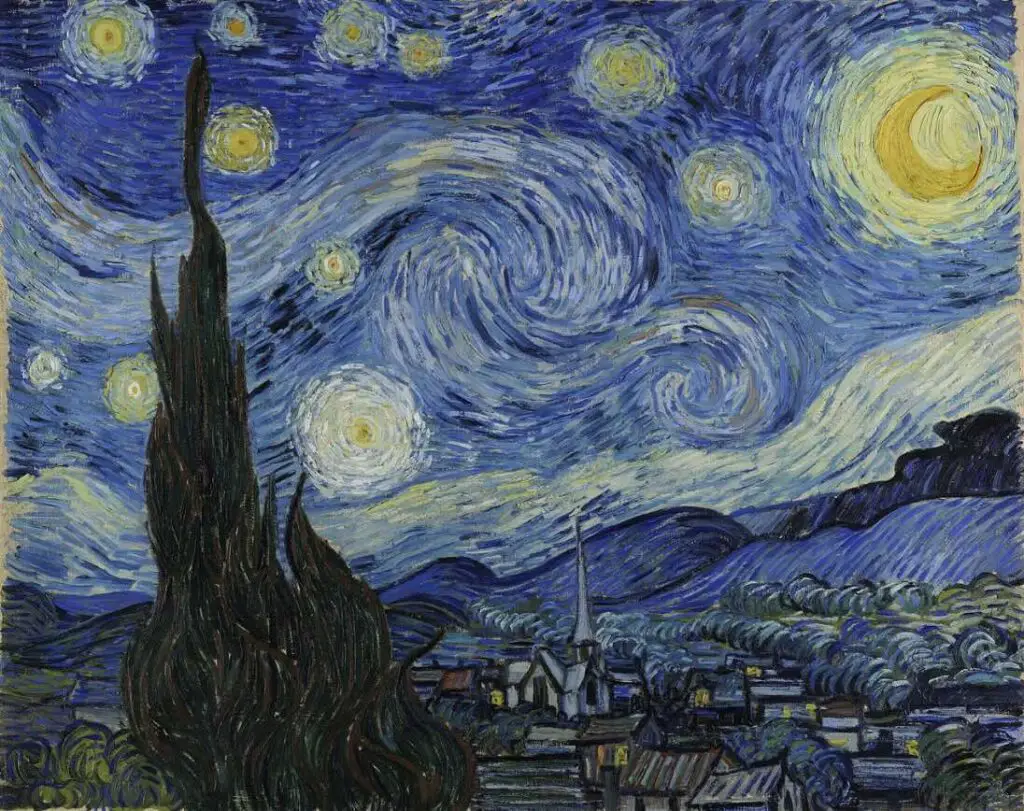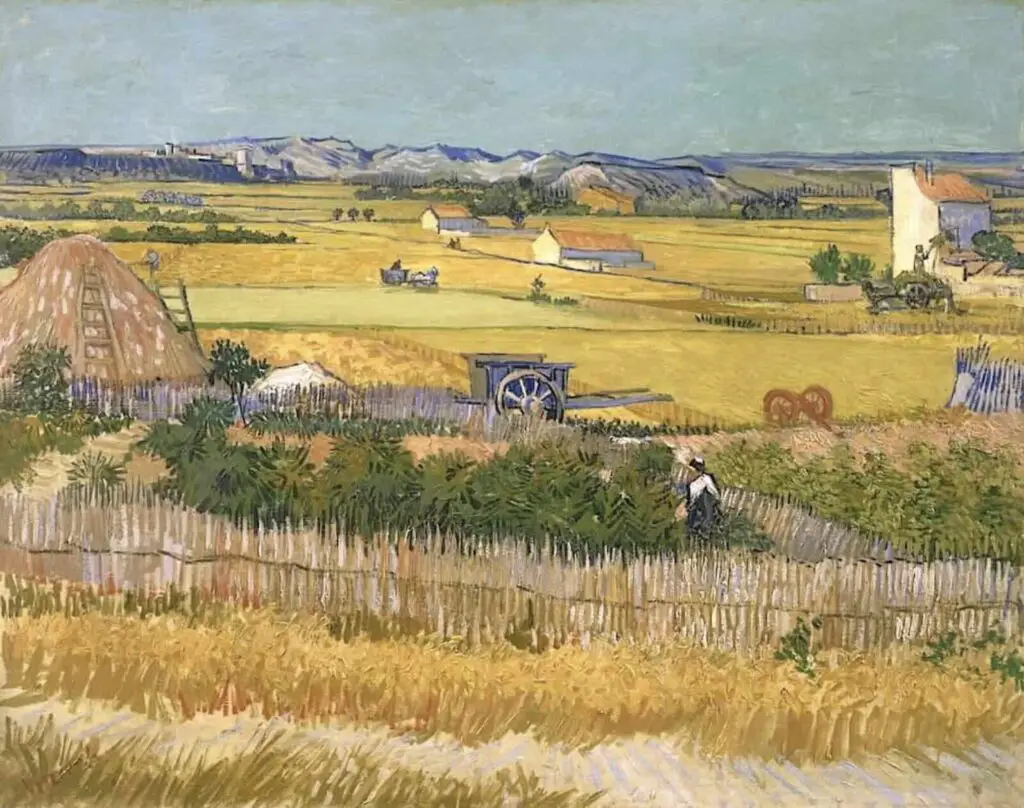Vincent Van Gogh, synonymous with passion, depth, and innovation, is celebrated in art for his unconventional take on landscape painting. His unique blending of colors, impulsive and expressive brushwork, and distinctive perspective have all left a remarkable imprint in art. Famous works such as Starry Night and Wheatfield with Crows beautifully encapsulate Van Gogh’s distinctive style.
However, his landscape art was also profoundly influenced by his environment, such as the hues of Holland and the vibrancy of southern France. Van Gogh’s artistry did not merely depict nature; it mirrored his interpretation of his surroundings, evident in paintings like ‘The Potato Eaters and ‘The Harvest.’ Additionally, his work reinvented landscape painting for his contemporaries and inspired and guided artists long after his time.
Table of Contents
- Understanding Van Gogh’s Unique Style
- The Influence of Environment on Van Gogh’s Work
- Van Gogh’s Revolution in Landscape Art and Its Legacy
- Related Questions
Understanding Van Gogh’s Unique Style

The landscape paintings of Vincent Van Gogh, a post-impressionist Dutch painter, have an extraordinary power and emotional depth. His unique style is characterized by bold colors, intense emotions, and dramatic, impulsive, and expressive brushwork that contributes to his paintings’ highly charged and emotional feel. This exploration delves into various elements that make Van Gogh’s style unique.
One essential aspect of Van Gogh’s unique style is his remarkable use of color, which gives life to his landscape paintings. Van Gogh was deeply influenced by Japanese prints’ bold juxtapositions of solid and flat colors and adopted this technique, making his works instantly recognizable. His colors, often bold and aggressive, provide a sense of heightened emotion and a powerful intensity.
Texture plays a critical role in Van Gogh’s paintings as well. He employed an impasto technique, applying paint thickly and leaving the brush strokes visible. Van Gogh’s thick application of paint lends a three-dimensional effect to his work, making them not just to be viewed but to be felt. One can almost ‘feel’ the wind rustling through the wheat fields and ‘smell’ the blossoming almond trees.
Also, Van Gogh’s tumultuous inner emotions are often mirrored in his landscape art. His landscapes are not just physical places but convey the artist’s emotional landscape. For instance, to understand the whirls in the skies of his painting ‘The Starry Night’, it’s essential to know his mindset at the time—his loneliness, his despair, but also his wonder and awe of nature.
Van Gogh’s signature brushwork is another defining element of his style. His paintings heavily feature short, forceful, and directional strokes. These impulsive, emotionally charged strokes add a sense of turmoil and movement to his scenes of nature. Ultimately, landscapes on Van Gogh’s canvas were not mere replicates of what he saw; they were experienced.
The inspiration behind Van Gogh’s landscapes also sets his work apart. Having spent his final years in the South of France, the beauty of the rural surroundings profoundly influenced his art. Paintings like ‘The Olive Trees’, ‘Wheat Field with Cypresses’, or the ‘Irises’ were all born out of the artist’s profound connection with nature.
Van Gogh’s unique style is not solely about visible characteristics. It is a fusion of his painting style, mental health, technique, and, most importantly, his perception of nature. The landscapes were his sanctuary, a place to escape and find peace. Van Gogh found solace in all the dense cornfields beneath the broad sky and amidst all the breathtaking stars.
His landscape paintings are a testament to his unique style, combining the outer realities of life with the complicated inner realities of an artist’s mind. This intersection of technique, emotion, and inspiration sets Van Gogh’s landscapes apart from others. In many ways, they continue to define him as the masterful artist we all admire today.

The Influence of Environment on Van Gogh’s Work
Take a step back to examine Vincent Van Gogh’s life; it should be noted that the diverse environments he inhabited were pivotal in shaping the evolution of his artistic style and approach to landscape art. It was not just about the landscapes he saw but the cultural amalgams and social dynamics inherent in these environments.
Born in the Netherlands, the Dutch artistic tradition heavily influenced Van Gogh’s initial work. His early pieces, such as ‘The Potato Eaters’, often portray the local rural life in somber earth tones. However, the muted palette would later give way to the vibrant colors he became renowned for as he moved to Paris in 1886. This artistic style and palette shift can be directly linked to his new environment.
In Paris, Van Gogh was introduced to the world of impressionism and post-impressionism, as well as the works of artists like Monet and Gauguin. During this period, he experimented with brighter colors and different lighting in his works such as ‘The Zouave’, a departure from his earlier work. Paris catalyzed an explosion of color and creativity that forever changed Van Gogh’s approach to art.
After years in the vibrant chaos of Paris, Van Gogh moved to Arles, a quieter town in the South of France, where he discovered a different light that differed significantly from the artificial glow of the Parisian nightlife. The serene landscapes and the soft, warm sunlight of the South of France awakened new tones and perspectives in his art. Works like ‘Starry Night Over the Rhone’, ‘Wheatfield with Crows’, and his famous ‘Sunflower’ series, marked a shift from the mirroring of physical reality towards a more emotional, subjective portrayal of the landscapes.
Van Gogh’s final stop was Auvers-sur-Oise, a community of artists not far from Paris. In this traditional rural setting mixed with proximity to a buzzing modern city, his work started showing some elements of his Dutch origins but with the color and passion he found in the South of France. Despite his deteriorating health, Van Gogh prolifically created 70 paintings during the last 70 days of his life in Auvers-sur-Oise, including his final piece ‘Wheatfield with Crows,’ reflecting an artist in turmoil.
The various environments in which Van Gogh lived had a significant and tangible impact on his landscape art. They offered him different perspectives and elements, helping shape and evolve his artistic style.
From the somber earth tones of Holland and the vibrant hues of Paris to the diffused, haunting light of Arles and the poignant scenes of Auvers-sur-Oise, each place etched its imprint on Van Gogh’s canvases and in the annals of art history. Even after his death, the landscape art of Van Gogh continues to inspire and move audiences, reflecting an artist who was deeply connected to his environment and was able to transform that connection into sublime works of art.

Van Gogh’s Revolution in Landscape Art and Its Legacy
While the first part of this article focused on Van Gogh’s brilliant use of color, textured brushwork, and his unique way of harnessing his emotional world in his art, it is equally pivotal to delve into how his landscapes revolutionized the realm of art and continue to leave a profound imprint today.
Van Gogh’s art journey began in his home country, the Netherlands, where he was heavily influenced by Dutch artistic tradition. However, the shift in his palette from somber browns and grays to vibrant hues, rich sunflowers, and electric blues unfolded in the whirlwind of art and culture that was Paris.
Perhaps one of the significant stepping stones in his artistic evolution was his introduction to Impressionism and Post-Impressionism in Paris. These movements encouraged artists to break free from the detailed, realistic art of earlier periods and instead aim for an absolute depiction of their emotions and impressions.
Van Gogh took these teachings to heart, allowing him to forge an approach that was unique to his emotional and creative disposition. Nothing reflects this better than his landscapes, where he rendered not merely what he saw but absorbed and experienced.
Here, it’s essential to highlight Van Gogh’s relationship with the landscapes he encountered, particularly in Arles, South of France. Van Gogh was not exclusively an observer but an active participant who deeply immersed himself in the landscapes he painted.
He was fascinated by the serene landscapes, warm sunlight, and the commingling of shades of Provence. His renditions of the French countryside are less accurate physical representations and more like emotional translations of how he experienced his surrounding environment.
Another pivotal phase in his artistic journey was when he moved to Auvers-sur-Oise, straddling the traditional rural setting mixed with the proximity to the modern city. His landscapes in Auvers-sur-Oise portrayed a return to the fields and nature, invoking his Dutch origins but rendered in the vibrant colors of his enlightened palette.
Despite an escalating battle with mental illness, Van Gogh was incredibly prolific during his time in Auvers-sur-Oise, painting one artwork a day for nearly 70 days. He reimagined and repurposed his surroundings, casting them onto his canvases in a unique and dynamic style that was distinctly his own.
Van Gogh’s landscape art, characterized by his signature style, sublime blend of colors, texture-rich brushwork, and emotionally charged portrayal of his environment, has forever permeated the art world. Today, his legacy continues to inspire and influence creatives globally, transcending the barriers of time and introducing every generation to the extraordinary depths of his genius.
In a nutshell, Van Gogh did not just paint landscapes; he seamlessly weaved them into art history. Undoubtedly, his work continues to exert a profound influence, underscoring his enduring significance and inspiring countless artists who seek to portray their emotional landscapes on the canvas of reality. His landscape art, therefore, is not just an indelible part of his artistic journey but an integral aspect of art history that continues to shape the course of art and culture.

With a powerful interplay of vivid colors, powerful emotions, and a strikingly uncommon perspective, Vincent Van Gogh etched a permanent mark in the annals of art. From the darkest tones of ‘The Potato Eaters’ to the blazing colors of ‘Harvest at La Craut,’ his landscapes unveiled the synergy between his life experiences, emotions, and chosen environment.
His daring departure from conventions embodies the revolutionary spirit that touched impressionism, shaped expressionism, and resonates profoundly in artists’ practices even today. This unique fusion of personal experiences and ground-breaking artistry has elevated Van Gogh’s works from mere paintings to timeless symbols of expression, making him a bright star in the constellation of art history.
Anita Louise Art is dedicated to art education, great artists, and inspiring others to find and create their art. We love art that uplifts and inspires. #ArtToMakeYouSmile! #ArtToMakeYouHappy!
If you want to see any of my art, you can find out more by clicking here. If you are interested in what inspires me and my paintings, you can discover more by clicking here.
We have a free newsletter and would love you to be part of our community; you can subscribe to the newsletter by clicking here. If you have any questions, I would be happy to talk to you anytime. You can reach me, Anita, by clicking here.
Subscribe to our Anita Louise Art YouTube Channel with great videos and information by clicking here.
Join us for our podcast “5 Minutes With Art.” Spend just 5 minutes a week with us to discover and learn about great art and artists. You can find out more about our podcast by clicking here.
Related Questions
How Much Is Van Gogh’s Starry Night Worth, And Other Facts
Vincent van Gogh’s Starry Night painting is considered priceless; many have estimated that the artwork is worth over 100 million US dollars. The Museum of Modern Art in New York City has had the painting in its collection since 1941.
By clicking here, you can discover more by reading How Much Is Van Gogh’s Starry Night Worth, And Other Facts
What Was The Impact Of Vincent Van Gogh On The Art World?
Van Gogh used color, form, and emotions in his art. He had a bright palette that was individualized for his time. Even though he did not see a lot of success during his life after he died, the impact of his art can be seen in both the Expressionism and Fauvism movements that were taking place in Europe.
By clicking here, you can learn more by reading What Was The Impact Of Vincent Van Gogh On The Art World?
Why Is Van Gogh Considered Such a Great Artist?
Vincent Van Gogh Starry Night painting is considered priceless; many have estimated that the price is worth well over 100 million US dollars. The Museum of Modern Art in New York City has had the painting in its collection since 1941.
By clicking here, you can discover more by reading Why Is Van Gogh Considered Such a Great Artist?

